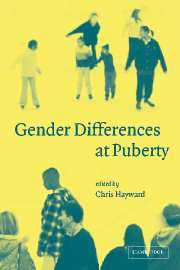Book contents
- Frontmatter
- Contents
- List of figures
- List of tables
- List of contributors
- Preface
- Acknowledgments
- 1 Methodological concerns in puberty-related research
- Part 1 Sex differences in hormones and their effect at puberty
- Part 2 Girls at puberty
- Part 3 Boys at puberty
- Part 4 Puberty and psychopathology
- Part 5 Pubertal timing: antecedents
- 10 Childhood sexual abuse and pubertal timing: implications for long-term psychosocial adjustment
- 11 Psychosocial factors predicting pubertal onset
- Part 6 Pubertal timing: consequences
- Part 7 Puberty and context
- Index
- References
10 - Childhood sexual abuse and pubertal timing: implications for long-term psychosocial adjustment
Published online by Cambridge University Press: 22 September 2009
- Frontmatter
- Contents
- List of figures
- List of tables
- List of contributors
- Preface
- Acknowledgments
- 1 Methodological concerns in puberty-related research
- Part 1 Sex differences in hormones and their effect at puberty
- Part 2 Girls at puberty
- Part 3 Boys at puberty
- Part 4 Puberty and psychopathology
- Part 5 Pubertal timing: antecedents
- 10 Childhood sexual abuse and pubertal timing: implications for long-term psychosocial adjustment
- 11 Psychosocial factors predicting pubertal onset
- Part 6 Pubertal timing: consequences
- Part 7 Puberty and context
- Index
- References
Summary
Although puberty is a normative event that is experienced by virtually every adolescent, the experience of puberty varies widely across individuals. As other chapters in this volume clearly show, puberty varies according to several basic dimensions, including when it happens, how quickly it happens, and so on. In this chapter we consider variations in pubertal timing as a function of a prior form of experience, specifically that of sexual abuse. Our goals are as follows: first, to introduce the topic of sexual abuse and to explore how sexually abusive experiences predict early pubertal timing; second, using an integrated bio-psycho-social perspective, to discuss how early entry into puberty may, especially for girls, exacerbate the effects of sexual abuse and increase the risk of adverse outcomes in postpubescence; and finally, we present preliminary evidence linking childhood sexual victimization, pubertal timing, and adolescent maladjustment within intra- and interpersonal domains.
What is sexual abuse?
The topic of sexual abuse has not been without its social and scientific controversies. Regarded as a relatively rare and innocuous event a half-century ago, the sexual abuse of children has reached the forefront of our collective awareness as a social problem of considerable proportion (Pilkington and Kremer, 1995). The first epidemiological studies of child sexual abuse (CSA) began in the 1920s; and research has long suggested that experiences of sexual victimization negatively impact a substantial number of children (Hamilton, 1929; Kinsey, et al., 1953; Landis, et al., 1940).
- Type
- Chapter
- Information
- Gender Differences at Puberty , pp. 187 - 216Publisher: Cambridge University PressPrint publication year: 2003
References
- 7
- Cited by



